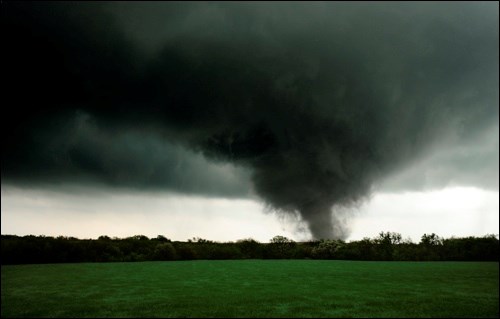Saskatchewan's resident tornado hunter, Greg Johnson, is on his way to the Battlefords this fall.
Relax, folks - a tornado is not about to hit.
Johnson is not coming to the Battlefords as part of his usual storm chasing activities. Instead, he plans to conduct a photo workshop Sept. 22 and 23 for those looking to improve their photography skills.
The two-day Intro to Digital SLR workshop is designed as a retreat, with 16 hours of intensive hands-on instruction in digital photography.
The workshop is about "helping people learn more about their camera, how to use it and how to get the results they are looking for," said Johnson. The goal is to teach participants how to manipulate the settings on a digital SLR camera to get the results they want.
This is one of several photo workshops the Regina-based Johnson has planned this fall around the province. It's the first time he's offered workshops to those in the Battlefords.
This week has been a very busy time for Johnson. Even though the summer tornado season in Saskatchewan has wound down for 2012, Johnson plans to spend this week chasing another big storm - Hurricane Isaac - which is due to make landfall somewhere in the Gulf Coast of the United States Wednesday.
Also in the works for Johnson is an appearance at Mosaic Stadium in Regina, called "Storming the Tailgate." That event will be held at the practice field just before the Saskatchewan Roughriders game Sept. 2, and will also include an appearance by fellow tornado chaser Reed Timmer and his famous "Dominator" storm-chasing vehicle.
It has proven to be an active year for Johnson chasing storms across North America, with many of the tornadoes landing close to home in Saskatchewan.
"In the United States this was the fewest tornadoes ever recorded," said Johnson. In Canada, on the other hand, Saskatchewan has been "off the charts good."
"Someone in my position, I'm kind of the benefactor of that situation," Johnson noted. In July, he said, Saskatchewan had more tornadoes than the entire United States put together. "That's unheard of."
One reason Saskatchewan had so many tornadoes this year has to do with the central United States hit with a high-pressure ridge that meant not a whole lot of severe weather for that area, producing a terrible drought.
"That forced the jet stream to kind of buckle a little," said Johnson, making its position directly overtop of Saskatchewan.
That by itself isn't unusual, he said, but "what's unusual about it is was that it was stationary there for just about the entire summer."
The other reason, said Johnson, was a surface layer of moist humid air, another key ingredient in the formation of thunderstorms and tornadoes. That, combined with the jet stream, produced the tornado development this summer on the prairies.
While a lot of tornadoes did develop this summer in Saskatchewan, the province's major cities were largely spared major damage from the funnel clouds.
"I've been referring to it as the perfect storm," said Johnson, who said there were lots of storms to chase but very little destruction.
He noted there was some damage in Smeaton and his team witnessed a tornado destroy buildings in a farmyard east of Regina, but other than those major events the tornadoes fortunately made their way through ranch land and unpopulated areas.
The active summer in Saskatchewan also included major wind and lightning storms that hit the Battlefords and also Prince Albert June 25.
Based on what he heard from talking to friends at Environment Canada, Johnson believes it was "straight-line winds" that caused the major tree and roof damage that night.
He also noted it seems typical for straight-line winds to cause exactly this sort of damage and financial hardship over a wide area.
"That was probably the most costly event of the entire summer," said Johnson.
Tornadoes, on the other hand, tend to be violent over a much smaller area, he said.
They can also be far more destructive, as Johnson found out in visiting the epicentre of the tornado that had hit Joplin, Missouri last year.
As documented in his photo book Blown Away, Johnson visited a populated area that was reduced to rubble by a deadly tornado.
"I hope there is nothing in my lifetime that compares to what I saw there," said Johnson.
When the News-Optimist spoke to Johnson Friday afternoon, he was planning a flight to Tallahassee, Fla. Sunday morning. From there, he planned to reposition to chase Hurricane Isaac, which was threatening to make landfall that weekend in south Florida.
As of Monday, forecasters projected Isaac would become a Category 2 hurricane this week, and was on track to possibly hit southern Mississippi or even New Orleans.
Johnson said he planned to head into the eye of the hurricane and look for a "stadium effect" from within that eye - the calm area that is within the centre of the massive storm.
"Literally, 360 degrees around you and 20 miles wide, you can actually see the cloud deck," said Johnson.
That "stadium effect" is "cherry for a storm chaser," he said, but he also wants to document the storm surge and any potential damage.
"Hurricanes are really just a series of thunderstorms rotating around the same direction," Johnson pointed out.
With the hurricane, there was one more side-effect inland - that tornadoes could be produced.
"Conditions are ripe," said Johnson, who said most people don't even think about the tornado aspect of hurricanes. Most just focus on the hurricanes themselves, he said, but the tornadoes can produce much of the devastation because the winds could be three times as fast.
The prospect of capturing images of both hurricanes and tornadoes in the Gulf Coast is what motivates storm-chasers like Johnson, who nevertheless looks forward to a far less hectic trip to the Battlefords after his latest adventures are over.




